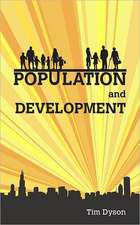How Long Do We Live?: Demographic Models and Reflections on Tempo Effects: Demographic Research Monographs
Editat de Elisabetta Barbi, John Bongaarts, James W. Vaupelen Limba Engleză Hardback – 7 apr 2008
| Toate formatele și edițiile | Preț | Express |
|---|---|---|
| Paperback (1) | 640.55 lei 6-8 săpt. | |
| Springer Berlin, Heidelberg – 30 noi 2010 | 640.55 lei 6-8 săpt. | |
| Hardback (1) | 646.43 lei 6-8 săpt. | |
| Springer Berlin, Heidelberg – 7 apr 2008 | 646.43 lei 6-8 săpt. |
Din seria Demographic Research Monographs
-
 Preț: 434.44 lei
Preț: 434.44 lei - 15%
 Preț: 639.73 lei
Preț: 639.73 lei - 15%
 Preț: 643.00 lei
Preț: 643.00 lei - 15%
 Preț: 641.85 lei
Preț: 641.85 lei - 15%
 Preț: 640.88 lei
Preț: 640.88 lei - 15%
 Preț: 642.51 lei
Preț: 642.51 lei - 15%
 Preț: 632.70 lei
Preț: 632.70 lei - 15%
 Preț: 639.73 lei
Preț: 639.73 lei - 15%
 Preț: 641.85 lei
Preț: 641.85 lei - 15%
 Preț: 635.65 lei
Preț: 635.65 lei - 18%
 Preț: 1001.95 lei
Preț: 1001.95 lei - 15%
 Preț: 643.65 lei
Preț: 643.65 lei -
 Preț: 433.85 lei
Preț: 433.85 lei -
 Preț: 424.22 lei
Preț: 424.22 lei -
 Preț: 430.21 lei
Preț: 430.21 lei -
 Preț: 386.00 lei
Preț: 386.00 lei
Preț: 646.43 lei
Preț vechi: 760.50 lei
-15% Nou
Puncte Express: 970
Preț estimativ în valută:
123.71€ • 128.68$ • 102.13£
123.71€ • 128.68$ • 102.13£
Carte tipărită la comandă
Livrare economică 14-28 aprilie
Preluare comenzi: 021 569.72.76
Specificații
ISBN-13: 9783540785194
ISBN-10: 3540785191
Pagini: 300
Ilustrații: XIV, 284 p. 58 illus.
Dimensiuni: 155 x 235 x 23 mm
Greutate: 0.59 kg
Ediția:2008
Editura: Springer Berlin, Heidelberg
Colecția Springer
Seria Demographic Research Monographs
Locul publicării:Berlin, Heidelberg, Germany
ISBN-10: 3540785191
Pagini: 300
Ilustrații: XIV, 284 p. 58 illus.
Dimensiuni: 155 x 235 x 23 mm
Greutate: 0.59 kg
Ediția:2008
Editura: Springer Berlin, Heidelberg
Colecția Springer
Seria Demographic Research Monographs
Locul publicării:Berlin, Heidelberg, Germany
Public țintă
ResearchCuprins
How long do we live? Demographic models and reflections on tempo effects: An introduction.- How long do we live? Demographic models and reflections on tempo effects: An introduction.- Theoretical basis for the mortality tempo effect.- Estimating mean lifetime.- The quantum and tempo of life-cycle events.- Critiques, extensions and applications of the mortality tempo effect.- Demographic translation and tempo effects: An accelerated failure time perspective.- Lifesaving, lifetimes and lifetables.- Tempo and its tribulations.- Tempo effects in mortality: An appraisal.- Increments to life and mortality tempo.- Mortality tempo versus removal of causes of mortality: Opposite views leading to different estimations of life expectancy.- Tempo effect on age-specific death rates.- Mortality tempo-adjustment: Theoretical considerations and an empirical application.- Comparison of period and cohort measures of longevity.- Five period measures of longevity.- Found in translation? A cohort perspective on tempo-adjusted life expectancy.- Conclusions.- Afterthoughts on the mortality tempo effect.- Turbulence in lifetables: Demonstration by four simple examples.
Textul de pe ultima copertă
The most widely used measure of longevity is the period life expectancy at birth which is calculated from age specific death rates by life table methods. In 2002, John Bongaarts and Griffith Feeney introduced the revolutionary idea that this conventional estimate of period life expectancy is distorted by a tempo effect whenever longevity is changing. The tempo effect is defined as an inflation or deflation of the period incidence of a demographic event resulting from a rise or fall in the mean age at which the event occurs. Some demographers agree with this radical argument; others disagree. The book reviews the debate on how best to measure period longevity. In the various chapters, leading experts in demography critically examine the existence of the tempo effect in mortality, present extensions and applications, and compare period and cohort longevity measures. The book provides a deeper understanding of and new insights into the fundamental question "How long do we live"?
Caracteristici
New methods and adjustments of existing ones for the measurement of human longevity First comprehensive book on this topic Tables, illustrations, examples for an intuitive and visually oriented demonstration of methods Includes supplementary material: sn.pub/extras
















